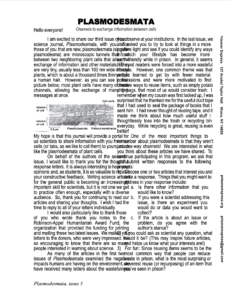Plasmodesmata: Channels to exchange information between cells
Hello everyone!
I am excited to share the third issue of our science journal, Plasmodesmata, with you. For those of you that are new, plasmodesmata (singular: plasmodesma) are microscopic tunnels that form between two neighboring plant cells that allow the exchange of information and other materials. They are very tiny, usually less than 100 nm wide in most plants, which is about a thousand times thinner than a human hair. However, as you can see in the picture below, most plant cells have many of these channels, allowing the exchange of many tiny messages at once.
My hope is that this journal will provide a portal for us scientists to share information with you from our cells (or labs, as we like to call them) to yours, much like the plasmodesmata of plant cells.
On behalf of the authors of the second issue, I would like to thank you for the thoughtful response letters. It is always interesting to hear your opinions and, as students, it is so valuable to receive your constructive feedback. Writing science articles for the general public is becoming an increasingly important skill for scientists, but it is not one we get to practice often enough, especially with a diverse audience. So, thank you for continuing to read our articles and sharing your thoughts. I wish I had the time to reply to all of your letters individually.
I would also particularly like to thank those of you who wrote thank you notes to the Robinson-Appel Humanitarian Award Fund, the organization that provided the funding for printing and mailing these two latest issues. We mailed your letters to the donors, who were very impressed. It is so encouraging to know that there are so many people interested in learning about science.
As many of the articles in the first two issues of Plasmodesmata examined the negative impacts humans are having on the environment, we have received many letters about the wastefulness you observe at your institutions. In the last issue, we also asked you to try to look at things in a more positive light and see if you could identify any ways in which your lifestyle has become more earth-friendly while in prison. In general, it seems like most readers were forced into a more wasteful lifestyle. However, one common theme was that people learned to get by with fewer material possessions and were more motivated to find creative ways to reuse items, such as empty potato chip bags, that most of us would consider trash. I remember when my cousin was first locked up, I was surprised that he thanked me for the useful duct tape that I had used to seal the package of books that I sent him. I had never thought of reusing tape, and it made me think about how much useful stuff I thoughtlessly toss into the trash or recycling bin every day. While recycling is great, reusing is even better!
One of the most important things to remember about plasmodesmata is that they aren’t just one-way channels! We are interested in what you think about these articles we have shared. To continue participating in this program, we ask that you submit written responses to the following prompts:
- Choose one or two articles that interest you and write a response. Things that you might want to address in your response include:
- Is there other information that you would like to know?
- If you were a scientist addressing this issue, is there an experiment you would do or data you would want to collect?
- If the article is about an issue or problem, do you agree with the author’s stance?
- If you could ask a scientist any question, what would it be? (This may inspire future articles, and helps us know what your interests are!)
- For fun: Since reusing items seems to be the most common way that people can reduce waste in prison, what is the most surprising or cleverest reuse (or repurposing) of an item that you’ve seen in prison?
I hope you enjoy reading this issue and look forward to reading your responses!
Take care,
Mia

